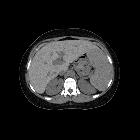hemosiderosis

Teenager with
autoimmune hemolytic anemia who has had multiple blood transfusions. Axial CT without contrast of the abdomen shows a marked homogeneous increase in liver density which is making the portal veins and hepatic veins appear to be low attenuation in comparison to the liver.The diagnosis was hemosiderosis.
Hemosiderosis (plural: haemosideroses) is a general term referring to the accumulation of hemosiderin, which particularly occurs in the reticuloendothelial system (RES) and does not cause organ damage.
Pathology
Some causes include:
- frequent transfusions
- mainly depositional siderosis in reticuloendothelial system (RES)
- if >40 units transfused: then may cause hemochromatosis (non-RES iron deposition)
- high erythrogenic requirements (hemolytic anemia, myelodysplasia)
- mainly depositional siderosis in RES from transfusion
- increased duodenal iron absorption may lead to hemochromatosis (non-RES iron deposition)
- bantu siderosis: rare cause in Africa due to iron-laden locally brewed beer
See also
Siehe auch:
- Morbus Wilson
- Thalassämie
- Hämosiderose der Lunge
- hyperdense Leber
- hepatic siderosis
- Hämosiderose in Lymphknoten
- hämosiderotischer fibrolipomatöser Tumor
- splenic siderosis
- reticuloendothelial system (RES)
und weiter:
- diffus hypointenses Knochenmarksignal in T1
- Gamna-Gandy Körperchen
- Pigmentierte villonoduläre Synovialitis
- Hämochromatose
- Autosplenektomie
- Siderose
- Knochenmark
- Ceelen-Gellerstedt-Syndrom
- primäre Siderose
- hepatic haemosiderosis
- Hämosiderose zerebral
- Hämochromatose Manifestationen an der Leber
- hemosiderosis in lymph nodes
- Hämosiderose Abdomen

 Assoziationen und Differentialdiagnosen zu Hämosiderose:
Assoziationen und Differentialdiagnosen zu Hämosiderose:



